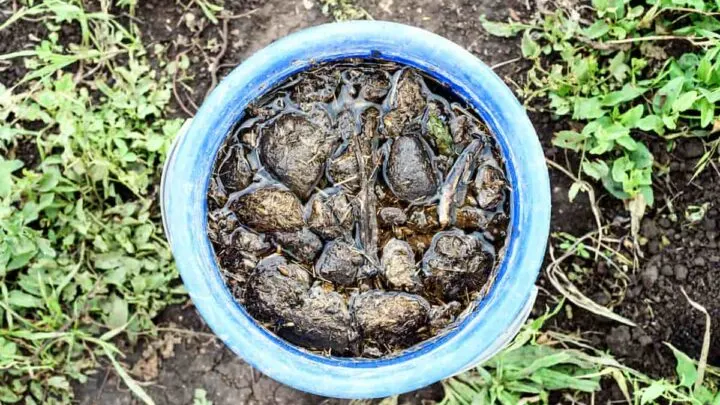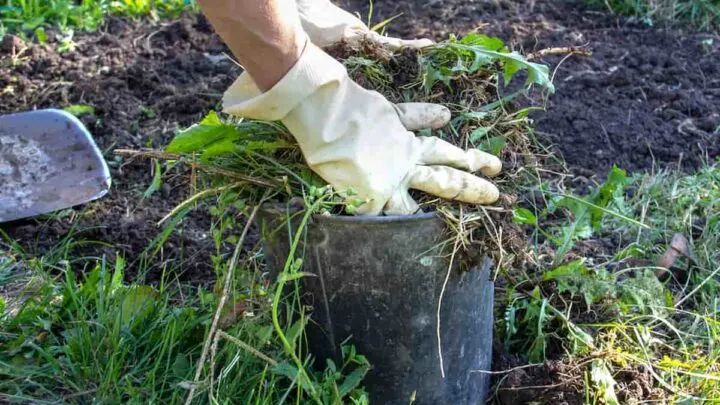Compost tea is a way to feed your plants a natural liquid fertilizer that benefits from the nutrients in the compost. It helps plants grow larger and healthier. When you make a batch, you may notice foam developing on the top. Why does compost tea foam?
The combination of bubbles from air pumped through the tea and the nutrients added to the mixture cause compost tea to foam. The amount of the foam can range from none at all to so much that it overflows the container. This phenomenon is influenced by the aerator type and nutrients added.
Now that you know why compost tea foams, you may have more questions. Let’s dive in to learn more about making compost tea, what the lack of foam means, and more.

What Affects the Amount of Foam?
Compost tea is made by steeping a bag of compost in water, adding nutrients, and aerating it with an air pump.
There are several options regarding what to include in the tea recipe. Popular ones are:
- Molasses
- Kelp meal
- Alfalfa meal
- Fish hydrolysate
The aeration adds oxygen to the solution to support the microbes and bacteria from the compost and eliminate odor. It also reduces the risk of any pathogens growing in the tea. Bubbles are formed from the aeration, which in turn collect into foam.
Foam indicates that there are proteins or carbohydrates in the mixture. Using fish hydrolysate or certain carbohydrates can create foam.
How to Reduce Too Much Foam on My Compost Tea?
Sometimes your compost tea will produce a large amount of foam. It might even overflow your container and spill onto the floor or ground, but this doesn’t affect the tea’s quality.
Usually, this is because there were dead earthworms in the compost. Their bodies will release protein and carbohydrates, which creates more foam. Certain additions to your tea, such as yucca or alfalfa, can also cause more foam.
If you want to control the foam amount, add a small amount of vegetable oil. Do not use olive or canola oil, and don’t use a commercial de-foamer; it will kill the organisms in the tea.
Why Isn’t My Compost Tea Foaming?
Although pictures of compost tea show foam on top, the lack of foam doesn’t mean the tea isn’t any good. There has been a myth that compost tea isn’t good unless there is foam. Your plants will still benefit from it.
The reasons your compost tea may not have any foam are:
- Enough time hasn’t passed. Compost tea won’t start to foam immediately.
- You missed the period when the foam was present. The foam may not stay for the entire tea-making process.
- Aerating for too long. The bacteria can die off if their food runs out. You can try adding some more molasses, kelp meal, or fish hydrolysate, and the foaming may start up again.

How Long Should I Brew My Compost Tea?
Brewing time is 12-48 hours. The temperature should be about 75 degrees or between 65 and 85 degrees. Any colder, and the process will take longer. Stirring the tea 2-3 times a day will help release the organisms in the compost into the water.
If it smells like ammonia, it’s been steeping for too long, and the bacteria is starting to die off. You must use it right away.
When you’ve decided the tea is ready, turn it off and take out the pump and hoses. You should use it within an hour or two.
You can either spread the compost from the bag onto your garden or dump it into the bucket of tea. Use at full strength for watering plants. If you want to spray it on the foliage, you’ll need to filter it beforehand so the sprayer doesn’t get clogged. Use at half strength.
Watering with compost tea when the soil is damp will allow it to be more readily absorbed.
You can make and use your compost tea monthly throughout the growing season. You can also use it on houseplants.
How to Make the Best Compost Tea
When your compost tea is foaming, the organisms and bacteria are happy and healthy. To achieve this, start with a good foundation:
- De-chlorinate the water. Unless you can use rainwater or well water, you will need to remove the chlorine from your tap water. You can either aerate it for a couple of hours or leave the bucket of water in the sun for a day.
- Use quality compost. If you don’t have your own compost bin, some companies sell compost in a bag with added nutrients all ready to go. If you’re using your own compost, you’ll need to make sure it has a balance of green material, high nitrogen material, and paper or wood.
- Ensure every part of the bucket gets oxygen. Do this by spacing the bubblers evenly. Readjust as needed after stirring if they moved.
Conclusion
Although some people think that if your compost tea isn’t foaming, it isn’t any good, you now know that is false. By making sure you have the best ingredients you can, you’ll have a high-quality compost tea.
Creating a tea from your compost will benefit both yourself and your plants. It allows you to fertilize more plants than if you used just the compost itself. They’ll be healthier, bountiful plants, and you’ll save money on commercial fertilizers. Using your own compost means less waste going into the trash.
Learning to make compost tea isn’t complicated. To have compost ready involves planning and buying the brewing equipment. All that’s needed is to assemble the ingredients and parts, turn it on, and stir it a little for a couple of days.

Hi there, my name is Allie and welcome to my blog; GareningWithAllie!
Much of what you see written here is just our personal experiences with gardening. Along with the content I write here, there is also a unique collection of gardening topics covered by some of our close friends. I hope you find everything you read here to be helpful, informative, and something that can make your gardening journey the most lovely experience ever! With that said, Happy Gardening!
